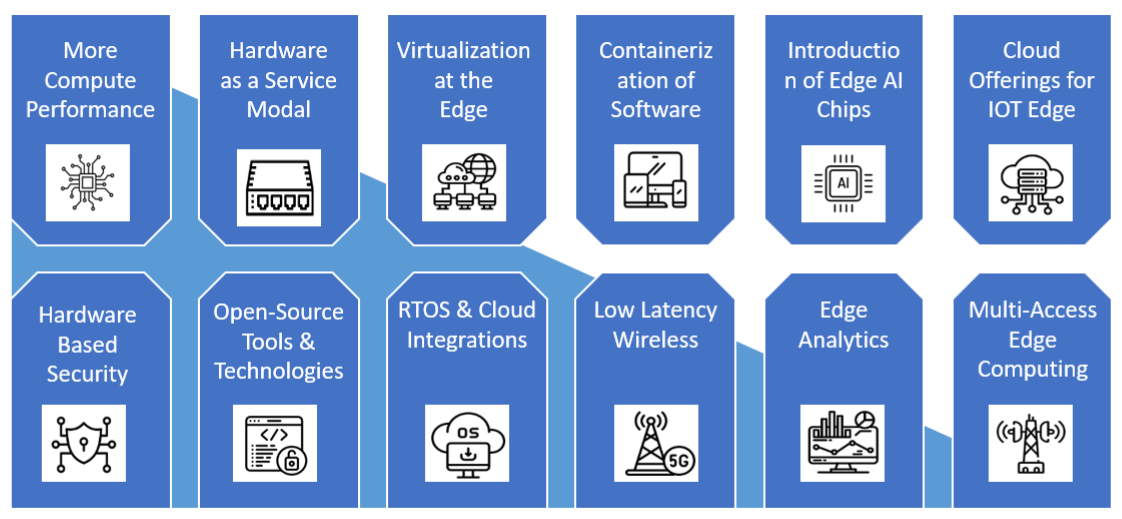In the ever-evolving landscape of technology, the concept of Edge Computing has emerged as a transformative force, reshaping the way data is processed, stored, and managed.
Unlike traditional cloud computing, where data travels back and forth between devices and a distant server, Edge Computing brings computational power directly to the "edge" of the network, reducing latency and enhancing real-time processing capabilities.
As we move towards an era dominated by the Internet of Things (IoT), 5G networks, and an insatiable demand for instant data processing, Edge Computing has emerged as the driver that ensures efficient, low-latency operations.
This technology is not merely an alternative to cloud computing but a strategic complement that addresses the limitations of centralized processing, making it indispensable in applications ranging from smart cities and healthcare to manufacturing and beyond.
Top Trends shaping Edge Computing

With inputs from various Analytics and Market research firms (including IOT Analytics), we have compiled the Top Trends shaping Edge Computing:
- More Compute Performance: In the dynamic realm of Edge Computing, a dominant trend revolves around higher compute performance. Advancements in Microcontrollers, Application Processors and FPGAs exemplify this trend, where the latest models boast unprecedented speed, efficiency, and compact sizes. For instance, microcontrollers like the ARM Cortex-M7 series now offer impressive computational capabilities in a compact form factor, enabling edge devices to process data with remarkable efficiency.
- Hardware as a Service Model: Another transformative trend gaining traction is the Hardware as a Service (HaaS) model. Major Original Equipment Manufacturers (OEMs) like Lenovo and Dell are actively steering this shift, providing a paradigm where organizations lease or rent hardware resources instead of making significant upfront investments. A noteworthy example of this trend is Lenovo's TruScale Infrastructure Services. With TruScale, Lenovo offers a flexible, consumption-based approach to hardware provisioning.
- Virtualization at the Edge: Virtualization has become a cornerstone in the current landscape of Edge Computing. Technologies like VMware's Edge Virtualization showcase the active implementation of this trend, allowing organizations to run multiple virtual instances on a single physical device. This enhances flexibility and scalability, optimizing resource utilization at the edge.
- Containerization of Software: Containerization is actively transforming the deployment landscape of edge applications. Docker and Kubernetes are prime examples of how this trend is realized in practice. These technologies encapsulate applications and their dependencies into portable containers, streamlining development and deployment processes while ensuring consistency across diverse edge environments.
- Introduction of Edge AI Chips: The integration of specialized Edge AI chips is a current and tangible trend in Edge Computing. Examples like NVIDIA's Jetson series highlight the deployment of these chips for on-device AI processing. This enables edge devices to execute complex AI algorithms locally, facilitating real-time decision-making without constant reliance on cloud connectivity.
- Cloud Offerings for IoT Edge: Cloud providers are actively tailoring services for IoT edge devices, exemplifying the convergence of Edge Computing and the Internet of Things (IoT). Microsoft Azure IoT Edge, AWS IoT Greengrass, AWS outposts are examples where cloud offerings seamlessly integrate with edge environments, providing comprehensive solutions for managing, analyzing, and deriving insights from IoT-generated data.
- Hardware-Based Security: The prioritization of security in Edge Computing is evident in the active implementation of hardware-based security solutions. Technologies like Intel's Software Guard Extensions (SGX), TPM Chips, ARM Trust zone showcase the integration of security features directly into hardware components, providing robust defenses against potential cyber threats at the edge.
- Adoption of Open-Source Tools & Technologies: Open-source solutions are actively driving innovation and collaboration in the Edge Computing ecosystem. Examples like Linux-based operating systems, Kubernetes, and TensorFlow exemplify the widespread adoption of open-source tools. This trend not only accelerates development but also fosters community-driven standards and interoperability within the diverse landscape of Edge Computing.
- RTOS & Cloud Integrations: Real-Time Operating Systems (RTOS) are actively integrated into Edge Computing architectures, exemplifying the quest for precise control over time-sensitive processes. Technologies like FreeRTOS and Azure RTOS showcase seamless integrations with cloud services, ensuring synchronized operations between edge devices and cloud platforms.
- Low Latency Wireless: Low latency wireless communication actively underpins Edge Computing applications. The deployment of 5G networks, Cellular 5G and WIFI6 and beyond are prime examples, enabling rapid and reliable data transmission between edge devices. This trend is crucial for applications like augmented reality and remote healthcare monitoring, where minimal delays in data transfer are imperative for optimal performance.
Few more notable trends worth exploring
- Federated Learning at the Edge
- Decentralized Identity Management
- Edge-native Applications
- Self-Healing Edge Systems
- Edge-to-Edge Communication
- Zero Trust Security Architectures
- Edge Data Governance and Compliance
- Predictive Maintenance with Edge Analytics
Conclusion
These trends are not just on the horizon; they are actively shaping the landscape of Edge Computing, influencing how organizations approach processing, storage, and analysis of data at the edge.
As we explore each trend (detailed articles coming up later), their tangible impact becomes clear, illustrating a dynamic and responsive ecosystem that continues to redefine the boundaries of computational capabilities.